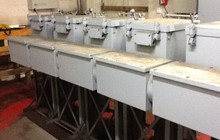
Arc Flash Fatalities in WA
Posted: Friday, 20 February 2015
High Voltage Solutions (HVS) proactive clients who have contacted HVS in recent weeks are concerned about Long & Crawford (L&C) oil filled switches & how best to determine how safe they are for personnel to operate.
Long & Crawford oil filled switches (ETV3/2, T4GF3 / GF3 / J / J3 / J4 / R3) have been around since 1970 (45 years of service up to 2015), a high percentage of these have been installed in underground substations / commercial buildings / hospitals / pumping stations where access is difficult to provide assistance if an incident occurred.
These oil filled fuse switches are used to supply adjacent transformers, which are also housed in the same location.
How it Should Operate
If a fault develops in one of the transformer related assets (Transformer winding fault / cable box termination or a cable fault) the resulting rupturing caused the striker pin within the fuse to operate causing the tripper plate to be activated which tripped the circuit breaker.
Fuse Performance
Electrical high rupturing currents fuses are used as protection devices in medium voltage systems such as 11000 volt transformers. There are two types of failure currents:
- Short circuit currents
- Over currents
Short Circuit Currents
Short circuit currents have to be handled so fast that the fuse operation limits the maximum current. The current limitation of the short circuit current will be handled by a fuse element with serial constrictions.
In case of a short circuit current all serial constrictions will melt off at nearly the same time. Due to the high number of foot – points of the serial arcs, the resulting arc-voltage is high enough to quench the arc and to interrupt the current.
Over Currents
With overcurrents the fuse element will melt at the hottest point. When the arc starts to burn it will be extended along the fuse element. To interrupt such an arc, the plasma has to be cooled to increase the electrical resistance of the arc to drive the arc – voltage above the recovery voltage. The cooling of the arc body appears by dissipating the heat of the arc into the fuse sand utilising the melt enthalpy of the sand.
A major problem occurrs if the plasma of the arc is stable burning & does not reach the necessary temperture to melt the quartz sand around 1700°C., as the arc will not be interrupted. Due to the pressure build up inside the fuse, the fuse body will explode.
Exploding Fuses Within Oil Filled Switches
If a fuse ruptures inside an oil filled fuse switch it will in most cases cause the oil filled switch to fail (This is subject to what back-up feeder protection is used up-stream from the oil filled switch).
General Rule Regarding Oil Filled Fuses
Uilities with oil filled switches with fuses that have been in service for over 20 years, run the risk of oil seeping into the actual fuse, this will cause the fuse to rupture under fault conditions.
In Root Cause of Failures
HVS has had extensive knowledge and experience in root cause of failures in oil filled equipment. Practical solutions to prevent the above from occurring so that personnel remain safe, have regularly been identified and rectified across Australia and New Zealand.
.jpg)